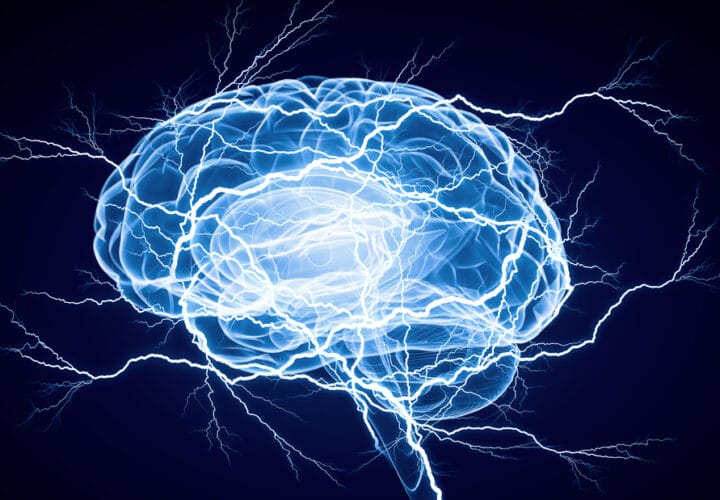According to neurologist Wendy Suzuki, "resculpting" the brain with exercise can help lower dementia risk by up to 90 percent.
We know that 150 minutes of weekly exercise may help prevent Alzheimer’s and that exercise can actually slow down the aging process, but what happens to the brain when we exercise? New York University neuroscientist Wendy Suzuki says that we can decrease our dementia risk by 30 percent just by walking and that exercise has been shown to improve cognition among those who have already received a dementia diagnosis.
- Suzuki says you can “re-sculpt” your brain with exercise, allowing it to grow new brain cells in the hippocampus and improving memory
- Research suggests that aerobic exercise is beneficial for the brain, but researchers are also looking into how non-aerobic resistance training could boost brain health
- Eventually, Suzuki hopes to develop personalized exercise recommendations that will optimize the impact your exercise routine has on cognition
Being Patient spoke to Suzuki about how exercise changes the brain, improves memory and decreases dementia risk.
Being Patient: What happens to the brain during exercise, according to research?
Dr. Wendy Suzuki: Exercise has immediate effects on the brain. It changes the neurochemical bath that your brain is bathing in; I like to call it a neurochemical bubble bath that you’re creating with exercise because it is increasing positive things like serotonin and dopamine that are making you feel good and putting you in a good mood. There are adrenaline and endorphins, which is the brain’s endogenous morphine that will help you withstand the pain you may be feeling from a run because there’s stress on your body as you run.
In the long term, there are more immediate effects. The other immediate effect that happens right after you run is that your prefrontal cortex, right behind your forehand, is working better. The prefrontal cortex is essential for what we call executive functions: ordering things, your focus, your attention, decision making. Those things work better. We’re not exactly sure why; it’s probably some of the growth factors that are being enhanced with exercise. The other thing that gets enhanced is your reaction times. You’re actually responding better and faster to different things, so those are all the immediate effects that everybody can benefit from. Typically, the maximum benefit comes from mid-level exercise—not exercise that pushes you that you’re so sore, you can’t move the next day, but exercise that causes you to feel really good afterward.
Being Patient: Regular exercise is essential to maintaining brain health, but are there long-term positive effects of having an exercise routine? For example, if someone went for a run this morning, would it have a long-lasting impact on their brain?
Dr. Wendy Suzuki: That is probably the most important effect of both aerobic physical exercise, and there’s some evidence that non-aerobic resistance training is also beneficial. That is changing the brain’s anatomy, physiology and function. As you continue to exercise, as you change your cardiorespiratory fitness, as your regular physical fitness goes up, your brain strength goes up at the same time because of that neurochemical bath. The more you keep those good neurochemicals that include growth factors that are helping new synapses to form, the better.
Those growth factors are actually stimulating the birth of brand-new brain cells in a key brain area that I’ve studied for the last 25 years called the hippocampus. It’s critical for long-term memory. So you can imagine the brain is kind of like a muscle; the more you exercise, the more growth factors you have, the more bubble bath-kind of inducing chemicals you make, and the bigger your hippocampus is because you have more cells, the bigger your prefrontal cortex is because you have more synapses up there and the axons work better because they have more insulation around them. You are literally re-sculpting your brain with exercise.
Being Patient: Does the ability to add brain cells as we exercise decline with age?
Dr. Wendy Suzuki: Absolutely not, and the great news is that studies have shown that even older adults, people 75 and older who have been diagnosed with Alzheimer’s or dementia, can benefit from a three-month exercise regimen. If they increase how much they exercise, you can see the effect on their daily dementia score. Everybody else who didn’t get exercise has a dementia score that goes up, and up and up, with higher and higher levels of dementia. Again, these are all the people who have already been diagnosed. After they started an exercise regime, their dementia score actually decreased. That says to me that you’re never too old to benefit from exercise.
You also asked about neurogenesis and whether there’s an age where that drops off. A lot of evidence suggests that the older you are, the less neurogenesis you have, but that study that I just quoted says that maybe neurogenesis isn’t every part of the explanation—that you can still benefit even if you’re over 75 and may have very little neurogenesis. Why? Because you’re still stimulating all those good neurochemicals every single time you exercise.
Being Patient: Can you give us some background on the development of the brain and the prefrontal cortex area? Is it correct that our brains develop until we’re about 25 years old?
Dr. Wendy Suzuki: Yes, that’s correct. The prefrontal cortex is one of the last developing areas of the brain, which explains why an eight-year-old is not the same as a 35-year-old. The major difference is the development of the prefrontal cortex. The brain is still growing and teenagers are still learning; there’s still hope for all those bad decisions you make at 16. They all resolve or at least get better with more development.
Being Patient: What does it mean when you say that we’re adding or making new brain cells? Does that mean those areas are becoming larger?
Dr. Wendy Suzuki: For hippocampal neurogenesis, you are actually birthing new brain cells. Now is it enough to double the size of your brain? Absolutely not. It’s a modest number of new brain cells, but they’ve shown in studies and in animal model systems that those brand-new brain cells that get stimulated by exercise are like teenager neurons. They’re very active and like to get involved in a lot of new memory circuits that the hippocampus is very involved in. So yes, at least in the hippocampus, it is the creation of a new brain cell that hadn’t been there before; that is what your exercise is stimulating.
Being Patient: How much exercise do we need to improve our brain health and do we have to reach a certain threshold to reap the benefits of exercise?
Dr. Wendy Suzuki: The data shows that regular walking can reduce your chances of getting dementia by about 30 percent; that’s nothing to sneeze at. But another exciting study that was just published last year looked at Swedish women in a 44-year follow-up study and showed that when these women were middle-aged, in their 40s back in 1969, they were measured and determined to be low-fit, mid-fit or high-fit. Then, they could go off and do whatever they wanted for 44 years. Later, they asked what happened to these women who were low-fit, mid-fit or high-fit. If you were high-fit, you were 90 percent less likely to have developed dementia. That tells me that we’re dealing with, in the range of exercise that’s attainable—these are not Olympic athletes here—we can change our probability of getting dementia by between 30 percent with walking and 90 percent with being a high-fit person.
Being Patient: When we exercise, we fire off endorphins. What is the relationship between endorphins and our brain?
Dr. Wendy Suzuki: Endorphins are the brain’s natural morphine, so it’s a painkiller for the brain. There was a big controversy over whether brain-derived endorphins were the underlying cause of a runner’s high that the press reported. In fact, it turned out to be true that endorphins underlie the runner’s high. That’s not everything. That’s a feel-good response, but serotonin and dopamine are also going up with exercise, so that’s also certainly contributing to your good mood. Those things alone are not protecting your brain necessarily. It’s really the growth factors that are playing a key role. In particular, there’s the brain-derived neurotrophic factor; people might have heard of BDNF. It’s a very important one that we know the most about in neuroscience, but there’s also a whole range of other growth factors that we think are very important as well.
Being Patient: Can you define BDNF and growth factors? Does that mean adding brain cells?
Dr. Wendy Suzuki: Growth factors are molecules that help with development when we’re babies and all the neurons are forming for the first time. In adulthood, these growth factors help new synapses to form, new connections, and BDNF, in particular, is essential in your hippocampus to help and create these new brain cells to be born, the neurogenesis in the hippocampus.
Being Patient: What do researchers need to learn more about when examining the connection between brain health and exercise?
Dr. Wendy Suzuki: At the end of every talk, everyone says to me, “Just tell me what I need to do specifically. I don’t want to know what the Swedish woman did or those other people did.” What I’m getting at is personalized recommendations. The research in my lab is getting at optimizing content performance for an individual. How can we individualize these reports for you, based on gender or your age at your fitness level, for your level of running, right now? First, what is that doing for your brain? If you see a clear difference when you’re exercising, let’s quantify that, let’s use standardized tests to manipulate that and see whether we can get it better. Maybe a slightly longer run would do something different, maybe a little shorter or more intense run. This allows me as a researcher to explore the precise kind of exercise, including novel exercises that you might not have done, but that stimulate your brain in a new way. We all like to do the exercises that we’re really good at, but new exercises that stimulate us and really force us to use our coordination in a new way are also very powerful to enhance brain function and may maximally enhance our cognition as well.
Being Patient: How do you engage some of your students with exercise routines?
Dr. Wendy Suzuki: I had gained 25 pounds and was focusing on work too much and not moving at all. I decided to go to the gym. That was my wakeup call. I needed to lose 25 pounds, change my diet, but the main difference was that I changed my regular physical activity and I noticed a huge difference—first, in my mood, that was absolutely clear, but then I noticed how much it changed my memory, dependent on the hippocampus, and my focus, dependent on the prefrontal cortex. That’s what got me fascinated with this general area of research.
The best way for a professor to learn a new area is to teach a new class. I’m an undergraduate teacher so I developed a new class called “Can Exercise Change the Brain?” Because it was inspired by me going to the gym, I decided I wanted to bring exercise into the classroom, so I made all the students exercise, and I’d exercise with them. Then, I would teach them about what exercise was doing to their brain. When my administration didn’t have any funds to pay for an exercise instructor, I decided to become an exercise instructor myself so I could teach the class myself. To their credit, my university paid for my teacher training because I was doing it all for the students, and so I went and got my teacher training, I practiced for six months straight to learn how to do this because I was a great student in the class, but it’s very different to actually lead a class. I did that and I was very nervous the very first day I did this workout, but then it completely changed my research life; it became the focus of my research life because I saw how much exercise transformed the classroom. It changed my teaching because it upped my level of engagement and it was very memorable for the students as well to be sweating with their professor. It was a great experience all around.
Being Patient: If you get too little sleep the night before, you end up feeling groggy the next day. However, sometimes when you exercise, you tend to feel better after a poor night’s sleep. Can you explain why that is?
Dr. Wendy Suzuki: It’s a balance. There’s certainly long sleep deprivation where it might be better to sleep in and not exercise, but people should experiment with themselves and find that point where, if they do drag themselves out of bed and go for a run, then by the end of the day, they may feel better and are able to function better that day. Both of these things that we’ve identified here, physical activity and sleep, are essential for optimal cognitive performance. Both are also malleable; you can change your exercise routine, you can put some hard and fast rules that I know a lot of us don’t do around sleep time: no screens near bedtime, that is terrible. Do not look at your phone. Do not look at your iPad. Don’t even watch Netflix—sorry, can’t do that. Because it is clear that good sleep is essential for your brain and what I love about exercise is that you not only get the benefits of exercise, all these neural chemicals and growth factors that go up every time, but exercise will then help your sleep the next night so it’s a double whammy of exercise addressing two of the key things we know are essential for optimum cognitive health.
Being Patient: What type of exercise is best, or should you find out what works best for you?
Dr. Wendy Suzuki: We know the most about the effects of aerobic activity and yes, aerobic activity that gets your heart rate up is great. Today, I was researching the most common forms of exercise that women do across the globe. In the United States, the most common form of exercise is walking. That’s fine because walking is aerobic. For a low-fit person, that’s the easiest way you can start to get your heart rate up. Just go for a good solid walk. You can always start there. That’s free.
Add one set of stairs and you up your aerobics right there. There is growing evidence that resistance training is also good. People, including in my life, are starting to compare and contrast high-intensity interval training with continuous aerobic exercise, with walking versus sitting.
We know a lot more about high-intensity interval training on muscles and the heart rather than the brain, so I think that’s a really interesting area of study, but what I recommend is moving your body in any way that you enjoy and that you do so on a regular basis. For everybody, I don’t care who you are, including me, the best way to move your body is walking. I live in New York City so I have to walk a lot, but there’s no dressing up in your expensive Lululemon, it’s just walking outside, and we know that has an effect on long-term brain health, decreasing chances of dementia, so that’s always the easiest answer.
Being Patient: You teach intenSati. Why did you choose to teach that?
Dr. Wendy Suzuki: I was pretty new at the gym and I was really excited. I was becoming a real gym rat. One night, I went into the gym and there was a choice: at 6 o’clock, I could take one of two classes, cardio bootcamp or intenSati. Cardio bootcamp just sounded too hard, so I chose intenSati. I didn’t know what it was, but I thought it had to be easier than cardio boot camp. It wasn’t easier. intenSati was developed by this amazing fitness instructor, Patricia Moreno. In ten comes from the word intention and sati is a Pali word that means mindfulness or awareness. So the practice of intenSati is the practice of bringing a whole new level of mindfulness to your own intentions. What do you want to do? What do you want to get out of this workout? It’s reminding you to feel and get into your body, but the workout itself is combining movements from kickboxing, dance, yoga and martial arts with positive spoken affirmations so that each move has a different affirmation, like “I am strong. I believe I will succeed. I am powerful. I’m inspired.” You string these moves and affirmations together in what’s called a series so you get a whole bunch of sweaty, affirmation-shouting people. While newbies to the class, and I know from experience, feel idiotic the first time, once you get over that, you realize that the shouting is increasing the cardio output. It’s increasing the strength of that workout, and you cannot feel bad if you shout “I’m strong” together with a bunch of people for a whole hour. You feel connected to the class and each other. That class really made me a regular. I couldn’t wait to go back, and that’s the class I trained to be a teacher for when I wanted to bring it back into the classroom.
Being Patient: You’re researching what types of exercise impacts the brain. Where do you see your research going over the next decade?
Dr. Wendy Suzuki: Step number one is optimized, individual cognitive performance. I want to move out of the scientific randomized control study pattern where “You have to do what I say. I choose spinning so you all have to spin.” I want to pay more attention to what you like to do. Maybe you hate spinning and you love running, so you run. But then exploring other things around running that you’re able to do and creating your own exercise program, based on that, that will maximize your brain function. Step number two is image your brain. When we found what optimizes your brain, let’s see what’s happening in your brain. But first, I want to know what that exercise prescription is for you. Then I want to image your brain. Then, I want to collect blood, because I can see BDNF in your peripheral blood system, and a lot of the other growth factors as well. Then, we get down to the actual neurochemical pathway and that is another way that we might be able to intervene. Does that give us clues? Maybe we can go and explore what exercise is maximizing BDNF and enhance hippocampal function even more. Those are the steps in my personal research program. Behavior, we need the behavior first, imaging and blood come next.
Being Patient: Do you focus on a specific age group in your research?
Dr. Wendy Suzuki: Yes, my age group is baby boomers, so 40–65, because this is the age when the very first brain changes are starting to happen if you have dementia or Alzheimer’s in your family history. This is a critical area where you can intervene. Other research focuses on university students because I have a lot of university students at my fingertips, but baby boomers are my main age demographic.
Being Patient: Where can we learn more about your research?
Dr. Wendy Suzuki: On my website, there are invitations to talks, classes I’m giving in New York City or your city, studies and a new startup company I’m developing.
This interview has been edited for clarity and length.




